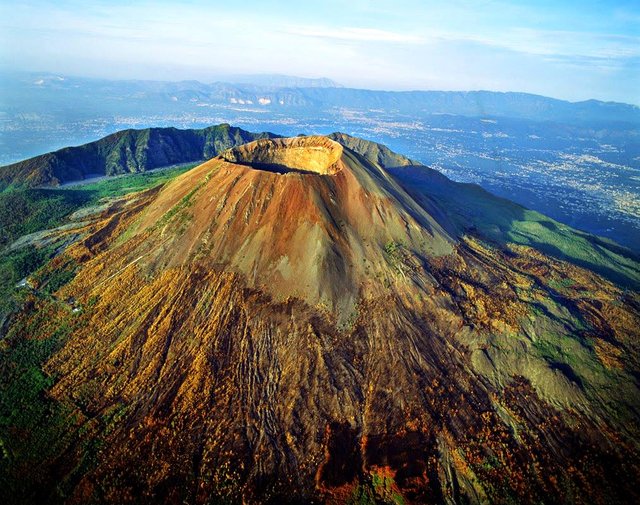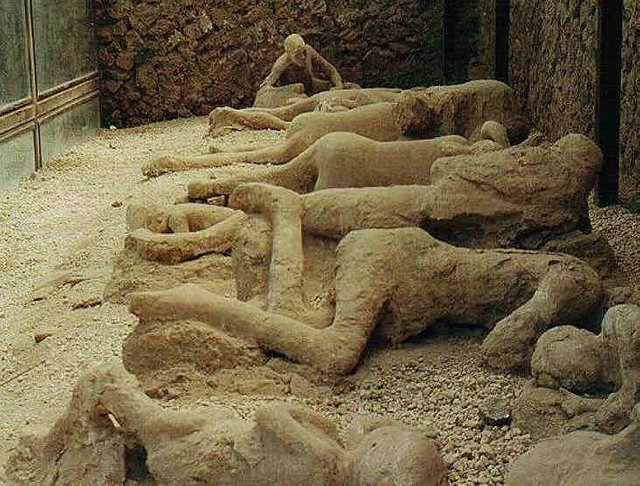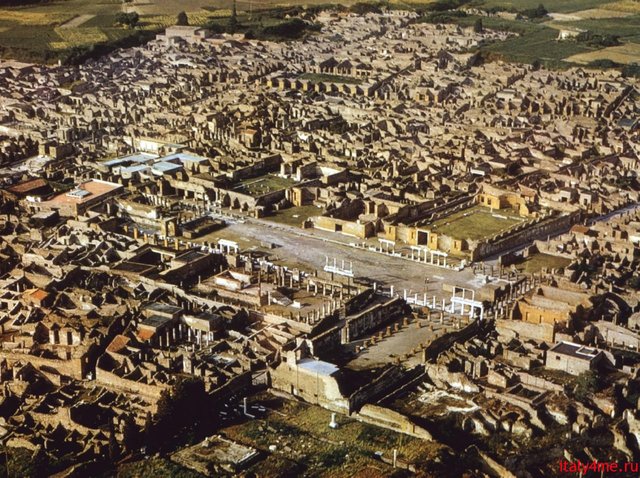Pompeii: those who saw the end of the world
All the horror is that a merciless catastrophe occurred in the center of a mighty state, in a rich city, in front of people who are confident of their exclusivity and that no disaster can happen to them. And therefore in one instant and forever buried under a six-meter layer of ash, dust and volcanic debris.
Apocalypse in Paradise
Under the black sky from the ashes, people fled, stumbled and fell, while others trampled on and fled. With children in their arms, with things on their shoulders, with gold in their pockets, and with wild horror and tears in their eyes - they fled, hoping that the sky will give them the last chance to escape from the already imminent death ...
It was like an apocalypse. The end of the world, the end of life. For the inhabitants of Pompey, he came on August 24, 79 AD. Until that time, the blooming city, which contemporaries compared with the elite resorts of the Côte d'Azur, lived a normal life.
Vineyards and olive gardens grew everywhere, wine flowed in the houses of wealthy people, bakers baked bread, merchants traded in fabrics and wool, slaves grazed cattle, hired Greeks taught children literacy, and women preened themselves before the mirror. It was indeed a paradise in the heart of the Roman Empire, where blacksmiths, shoemakers, seamstresses, jewelers arrived in search of robots. But, such Pompeii did not immediately begin.
The first settlement on the outskirts of Naples was founded in the IV century BC. Approximately in the year 290 BC, the city fell under the influence of Rome, whose troops advanced to the south of the Apennines. The Pompeii, which stood on the seashore, became an important point on the trade route between Rome and Southern Italy, and this contributed to their development.
Very soon, thanks to the production and sale of wine and olive oil, the city turned into one of the well-developed centers of the Roman Empire. With the booming trade came money - already in the II century BC. Pompeii was actively upset, residents erected luxurious villas, decorated with frescoes and mosaics, built a "social housing", which was filmed by people from poor strata of the population, and the streets of the city were decorated with antique sculptures.
In Pompeii lived and worked well-known representatives of science and culture, here regularly visited famous political figures of the time. Mighty settlement had everything inherent in the megacities of the Roman era: the amphitheater for the fights of the gladiators, the forum (the central city square), the curia, the temples of the Roman gods, the basilicas, the two theaters, the circus and even our own lupanarii - a brothel!
But then, nearby, 15 kilometers away, towered and the future killer of the city - the famous volcano Vesuvius, which is still the only active, most dangerous volcano of mainland Europe.
Save who wants to
On a trouble to inhabitants of Pompeyev in I century of our era of serious and system supervision for volcanoes nobody conducted. Although, most likely, it would not help - Vesuvius did not show activity from the Bronze Age and was considered long gone. In 73 BC. the rebels with Spartacus, the gladiators hid from the Romans in a volcano covered with vegetation. No one felt the slightest danger from the neighborhood with Vesuvius! On the slopes with fertile soils willingly erected villas, along the coast built numerous fishing settlements.
The volcano seemed so safe that even strong tremors in 62 AD, which caused minor disruptions in Pompeii, the neighboring Stadia and Herculaneum, did not become a warning, although they were harbingers of the impending eruption. People did not want to believe that such a majestic city could suddenly cease to exist. Until the fatal date for Pompey came - August 24, 79.
About the eruption of Vesuvius, which took two days, we know quite a lot, thanks not only to archaeological excavations, but also from the letters of the famous politician Pliny the Younger. It all started early in the morning when a cloud of ash and steam appeared over the volcano. No one paid much attention to this - everyone was preoccupied with everyday affairs. Furthermore! At noon, gladiator fights were to be held in the amphitheater - the men hurried to the spectacle, and their wives waited for the guests and set the tables for dinner.
Closer to dinner over Vesuvė, the cloud of white-brown color began to grow rapidly. She climbed into the sky, spreading at a height like a pine-like crown. Near the volcano there was a terrible roar, uninterrupted tremors were felt even for 30 kilometers in the city of Miseno, where just was Pliny the Younger.
For an hour, Vesuvius threw a huge column of red-hot ash into the sky, a dark cloud covered Pompeii. Underground shocks pinched windows, destroyed obelisks. Tiles fell from the roofs. The eruption began - a gas jet that burst from the depths of the volcano, carried along with it huge pieces of pumice. Within 10-11 hours of continuous eruption, the column of ejected pumice reached 32 kilometers in height! Together with the ashes from the sky began to fall stone balls the size of a chicken egg.
Despite all the horrors of what was happening, for the residents of the city the catastrophe was not a lightning event. Time to save was still! Ash deposits, although complicated breathing and movement around the city, but were not fatal. He was wiser, more circumspect and was able to assess the threat, and there were a majority of 20,000 Pompeyans who left the city without waiting for death under the rubble of their homes.
The rest, who, because of greed or frivolity, did not want to say goodbye to their possessions, hid in the deep cellars of houses, hoping for salvation. By evening in Pompeii, there were mostly seriously ill, old and feeble, pregnant women with servants and slaves left to guard the property of the owners. The streets and houses of the city were filled with poisonous sulfur fumes, but about two thousand Pompeyans still remained in their homes ...
At night, wide flames began to burst from Vesuvius. Behind them stood a huge pillar of fire. This horrifying sight lasted all night, and on the morning of August 25, heavy incandescent avalanches began to descend from Vesuvius. The magma, saturated with gases, was dumped by a burning cloud from the slopes of the volcano.
Modern researchers say that this so-called pyroclastic flow (a high-temperature mixture of volcanic gases, ash, stones, capable of speeding up to 700 km per hour) and caused a fatal blow to Pompeii. Three such streams covered the neighboring city of Herculaneum, where in one instant they destroyed all living things, and the fourth pyroclastic stream buried the inhabitants of Pompeii.
By the way, it was traditionally believed that the death of the inhabitants of Pompey was long and painful, because they inhaled the ash, which in the lungs turns into a kind of cement and blocks breathing. But the Naples volcanologists, led by Giuseppe Mastrolorenzo, denied this theory. They came to the conclusion that the victims were not suffocated, their mouths were not sucking, they were instantly killed by the pyroclastic flow.
After the disaster, a special commission arrived at the scene of the event, stating "death" of Pompeyev and the fact that the city is not subject to restoration. After the eruption of the volcano, the city was covered with a 6-meter layer of ash and stones, which loomed threateningly like an avalanche, capable of descending at any time. A few days later a shower followed, which washed away a thick layer of ash from the slopes of the volcano, and the stream of water with ashes and stones rushed to Herculaneum. The depth of the stream was 15 meters, so this city was also buried alive in a stream from Vesuvius.
However, it was these murderous pyroclastic flows that "conserved" Pompeii along with its inhabitants in the state to which they arrived at the time of their death. Those who survived did not attempt to excavate at the site of the tragedy, they simply moved to new lands, and Pompeii was forgotten for a long time.
In the XVI century, architect Domenico Fontana, laying a canal, came across a wall with an inscription where Venus Pompeia, the patroness of the city, was remembered. Immediately found and ancient Roman coins, for a while this territory became a paradise for gold diggers. Over time, they were replaced by hunters behind rarities - statues and other historical relics.

(*)
However, a full excavation in almost two centuries, in 1863-1875, began the Italian archaeologist Giuseppe Fiorelli. It was he who discovered that in the place of bodies of people and animals emptiness was formed. Filling these voids with gypsum, he could reconstruct the dying poses of the victims of the eruption. Covered with ashes and pumice stone, the city gradually grew out of ruins, and it seemed a real miracle - houses, frescoes on the walls, fountains in gardens, dishes in stoves remained under the rubble.
In the next two centuries, archaeological searches, one might say, did not cease - from under the thickness of the earth there were preserved almost unharmed houses, architectural structures and bodies of about 2 thousand dead. This was confirmed by Pliny's testimony that the main cause of death was the poisoning of gases that enveloped the city during the eruption. Until the beginning of the 1980s, scientists have restored about 3/5 of the city's territory, and until now tourists are walking along the cleared streets of ancient Pompeii.


Painful 😖 story
You got a 1.28% upvote from @buildawhale courtesy of @pioner888777!
If you believe this post is spam or abuse, please report it to our Discord #abuse channel.
If you want to support our Curation Digest or our Spam & Abuse prevention efforts, please vote @themarkymark as witness.
Hey.)
I will be glad to meet you
my profile pays rewards from 50-70% for app)
subscribe and I will be glad to communicate with everyone
You got a 0.94% upvote from @postpromoter courtesy of @pioner888777!
Want to promote your posts too? Check out the Steem Bot Tracker website for more info. If you would like to support the development of @postpromoter and the bot tracker please vote for @yabapmatt for witness!
@pioner888777 perfect topic and info. I had used the pompeii story in one of my stories i had wrote once. Resteemed😊😊😊😊
Your post had been curated by the @buildawhale & @ipromote team and mentioned here:
https://steemit.com/curation/@buildawhale/buildawhale-curation-digest-02-26-18
Keep up the good work and original content, everyone appreciates it!